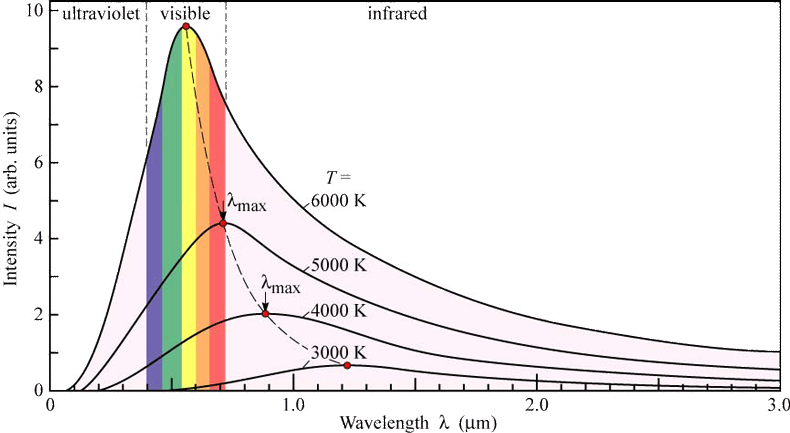
Instead, we will simply assume that a star is a dense object of finite temperature whose emission of radiation can then be properly characterized by the planck function. You may have seen this function before expressed in units of frequency

If you plot that function you get a characteristic curve whose peak only depends on temperature:

For simplicity, we assume the sun (or any star for the moment) to be pure hydrogen.
The mean density of the sun found from its mass (2x1033 grams) and its radius (7x1010 cm) is 1.4 grams cm-3.
The mean temperature gradient in the sun is approximately equal to
the core temperature divided by the radius. The core temperature
of the sun is approximately 15 million degrees (to be discussed in
more detail later) which leads to
a temperature gradient on the order of 10-2 K/meter.
 This will become important later when we discuss the mean free path
of photons in the solar interior.
This will become important later when we discuss the mean free path
of photons in the solar interior.
Next we will demonstrate how integrating the planck curve shows that the total energy of a star depends on the fourth power of its blackbody temperature.
You integrate the planck function over all wavelengths, make a variable substitution to produce an integral that you can look up in a book and voila:

The planck function is an accurate description of the radiation given
off by a dense object as long as thermodynamic equilibrium holds. Thermodynamic equilibrium represents a particular condition that holds
between matter and radiation.
Under TE, the temperature of the matter and radiation are the same.
The only way this can occur is if the radiation shares energy with
the matter. This condition occurs whenever the radiation can not
travel very far through matter without being absorbed or scattered.
This condition is known as opacity
If you consider radiation passing through a slab or layer of material,
the amount that radiation interacts with the material depends on
three things:
We can write the reduction in intensity, dI, as a function of these
as follows:
 dz
dz
 ρ
ρ
 The determination of this
coefficient is one of the more difficult things to do in making a stellar
model that is not based on pure hydrogen.
The determination of this
coefficient is one of the more difficult things to do in making a stellar
model that is not based on pure hydrogen.
For a layer at about 1/2 a solar radius, κ = 1 (in cgs units) and we can take the density at this location to be the same as the mean density of the sun, which is about 1 as well.
Hence, at this layer, the mean free path of radiation is only 1 cm. This means a photon can not travel any more than 1 cm without interacting with the matter and then being randomly scattered by that interaction. Hence, photons diffuse through stars, they can not travel directly through them due to the very low mean free path. They do this by a random walk process of step length about 1 cm. The sun has R = 7e10 cm ~1011 times larger than the step length.
Note that the above is oversimplified. In the very core of the sun the the mean free path of
photons is closer to .05 cm than 1 cm. When you integrated over density in a real solar model
you therefore find the diffusion time scale for the sun is about 105 years instead
of 104 years.